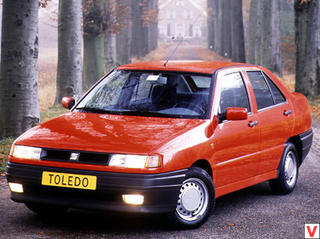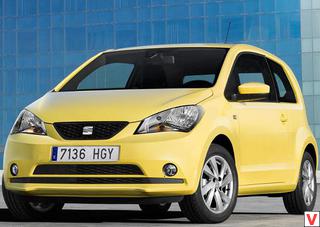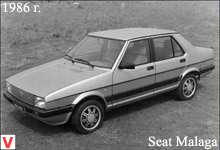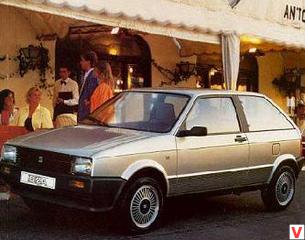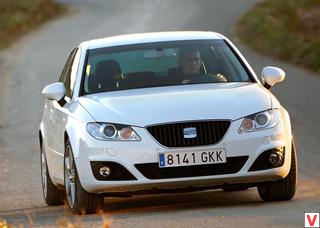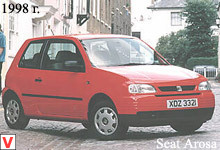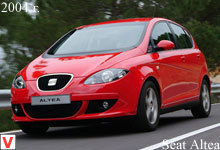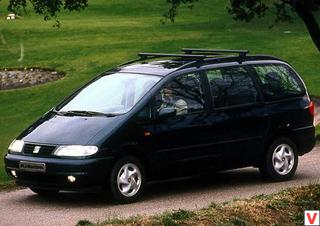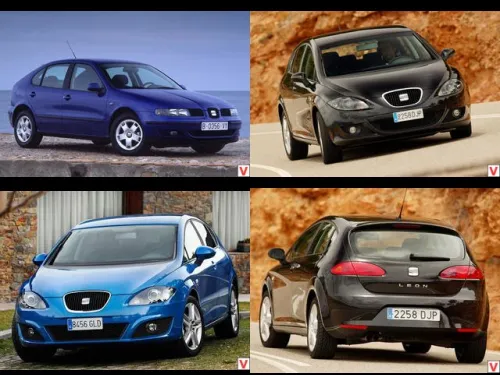
Leon hatchbacks (from Spanish - “lion”) have been produced by Seat since 1999. The development of this model started back in 1997. Moreover, they collected a prototype of the first generation bit by bit. The platform (PQ 34) was inherited from the fourth-generation Volkswagen Golf, the technical stuffing came from the same Golf, as well as the Skoda Octavia. Elements of the interior model borrowed from the first generation Audi A3. The famous Italian couturier Giorgetto Giugiaro worked on creating a unique image.
Unlike its progenitor Golf, Leon got a more aggressive exterior design, a stiffer suspension, a sharp steering wheel, in a word, was a more sporty and oriented model, above all, to a youth audience. Standard versions of this five-door hatchback were equipped with three petrol (volume 1.4, 1.6 and 1.8 liters) and turbo diesel (volume 1.9 liters) engines. The basic versions of the Leon were equipped with a semi-dependent torsion beam, whereas in expensive trim levels it was replaced with a multi-link independent rear suspension. In addition to Spain, the car was also produced in Belgium.
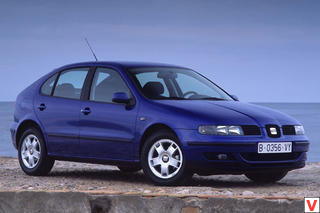
The first generation Seat Leon was taken off the assembly line in 2006, although the second generation of this model was already selling in the markets. Leon second generation debuted in 2005. But only at the end of 2007, when the Russian representative office of Seat was opened, Leon II officially reached our market. The body of the car has increased in size, it was built on the new platform Volkswagen A5 (PQ35), on which the Golf V and Skoda Octavia A5 were also based. The car turned out to be compact and not too heavy (weight approaches 1.4 tons). Leon II acquired more aggressive exterior features, which were worked on by the famous Volkswagen concern designer Walter da Silva.
A distinctive feature of the exterior of the second generation steel rear door handles, integrated into the rear window pillars. The profile of the car was decorated with embossed stampings, and the grille increased in size. This model has a drag coefficient of 0.32.
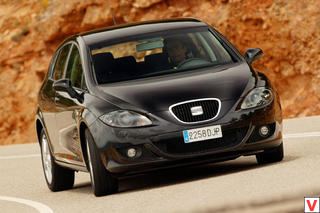
The interior is made with a claim to sportiness. First of all, anatomical seats with strong lateral support should be distinguished. Both the seats and the steering wheel are adjustable in very wide ranges, so that the correct fit is guaranteed to the driver of any stature. The instrument panel is dominated by red - it is in the backlight of the display, the instrument arms, the upholstery of the seats. The center console “sporty” is trimmed with satin-finished aluminum. The volume of the luggage compartment increased by just a liter, compared with the previous generation and amounted to 341 liters.
Leon is equipped with three petrol engines: 1.2 TFSI, 1.6, 2.0 FSI and 2.0 TFSI with 105 - 185 hp. Two diesel engines are also offered: 1.9 TDI and 2.0 TDI in 110 - 140 l. from. Low-powered engines 1.6 and 1.9 TDI are equipped with a 5-speed manual gearbox, and the rest - 6-speed. In addition, 2.0 TFSI and 2.0 TDI can be paired with both classic “automata” and DCT type boxes (DSG). In 2009, Leon has undergone a slight restyling, which almost did not affect his appearance. The Spaniard got a new bumper with sharper edges of air intakes and other body side mirrors, even he slightly tweaked the tailgate, which received an enlarged glass - for better visibility.
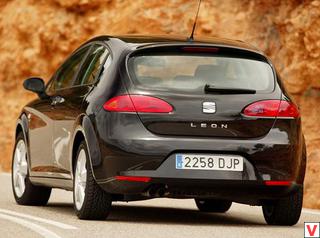
On the new grille flaunts, reduced in size, brand logo of the brand. Head optics slightly increased in size, and the taillights diluted with LEDs. Interior updates touched primarily finishing materials. It is worth noting some changes in the dashboard and center console.
In addition, there are new steering wheel and gearshift. A number of petrol and diesel engines inherited from the first generation Leon were modernized (the 1.4-liter engine received turbocharging), besides this, completely new turbocharged units appeared - gasoline (1.2 and 2.0 liters) and diesel (1.6 and 2.0 liters). In addition, in 2009, the Leon began to install a 1.6-liter bit-fuel engine running on liquefied gas. The choice of the proposed transmissions also expanded: 6-and 7-speed DSG robotized transmissions were added, and the 4-speed “automatic” was discontinued.
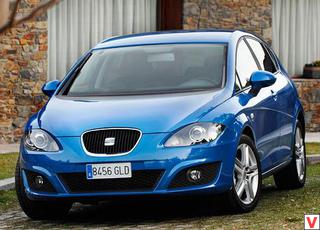
The third generation Seat Leon was presented at the 2012 Paris Motor Show. For the first time in its history, the model received a three-door version. Later, in 2014, at the Frankfurt Motor Show, the company plans to present the Leon version in the station wagon.
According to representatives of the company Seat, the car was almost created anew. The car is traditionally based on the Volkswagen Golf platform, this time the Golf VII. Dimensions of the car decreased. Leon III became shorter by 50 mm (4263 mm), width - 1816 mm (1784 mm without mirrors), and height is equal to 1459 mm. By the way, the height of the ceiling in the cabin has increased significantly due to the fact that the car has lost a sloping roof. The wheelbase, on the contrary, has grown by as much as 60 mm to the mark of 2,636 mm (due to the location of the power units under a 12-degree slope).
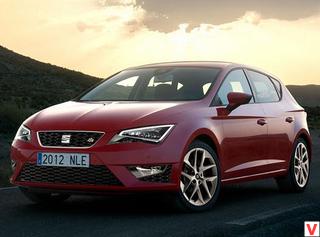
The ground clearance of the Seat Leon 3rd generation is equal to 142 mm. In the basic version, the car weighs as much as 90 kilograms less than its predecessor, the curb weight is 1,113 kilograms. Despite the fact that the car "lost weight", its body became tougher by 15%. Design has become more utilitarian. The car lost its signature "barrel", elongated taillights and body shape, made in the style of "droplets". The front part of the car was transformed: the grille turned from a small semi-oval “patch” into a wide, inverted trapezoid.
Another was the front bumper, in which a wide section of the central air intake appeared in the form of a regular trapezoid (the previous generation had a “trapezium” turned upside down), and rhomoboobraznye side sections, into which rectangular fog lamps were integrated. Another form acquired hood, which appeared stylish vyshtampovka in the middle and two more - on the sides. The wheel arches did not become so convex, but the arc-shaped vyshtampovka disappeared from the sides of the body, which went from the front wing through the entire side downwards, to the middle of the rear wheel arch.
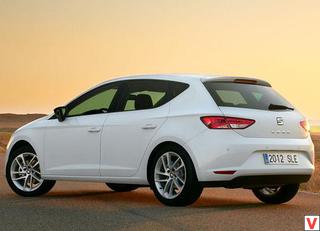
The Leon profile is underlined by two stylistic lines running under the windows of the side doors, going towards each other. Designers and custom handles returned to the rear side doors. Not without transformation and aft car. The changes affected the optics: the taillights acquired the form of narrow, sharply honed wedges, which are divided into two parts - at the top of the red brake lights, at the bottom - transparent reversing lights. Slightly corrected tailgate and rear bumper.
Leon III is equipped with fully LED optics, which has many advantages. First, the LEDs are significantly brighter than lamps. Secondly, they are more durable (these headlights are designed for the entire life of the car). Thirdly, the LEDs consume less energy, which reduces the load on the engine (in the dim light only 20 watts per headlamp). The headlights are also notable for their shape - Seat abandoned the feline optics, making the choice in favor of a more classic design with a sloping line.

Inside the car also noticeably changed, got new seats, additional free space. The control panel, steering wheel, instrument board are united by designers into one common driver zone and constitute a single whole. The front panel has a convenient geometry, and the upper part of the center console is slightly turned towards the driver, facilitating access to the ergonomically grouped controls. Interior noise insulation at the highest level.
There are different color combinations of the cabin - from the usual dark to two-color. The trunk volume has increased by 39 liters and is now 380 liters, and with the assembled rear seats it rises to 1,210 liters. The engine range for the Seat Leon III is quite wide, but in Russia it is presented in a truncated version.
Leon 2012 in Europe can be purchased with gasoline units from 1.2 to 1.4 liters and diesel from 1.6 to 2.0 liters. Moreover, all engines are available in two versions, in addition, any modification can be equipped with a start-stop system. The most powerless of all was the 1.2-liter engine, which produces 86 horsepower. Exactly the same TSI engine with direct injection can have a power of 105 "horses." Due to the small mass, the car already with this engine boasts an acceptable dynamics - acceleration from standstill to 100 kilometers per hour takes 10 seconds, and the maximum speed is 191 kilometers per hour.
With a 1.4-liter TSI (122 horsepower), Leon shifts the “hundred” in 9.3 seconds, and with the same engine, but in a 140-horsepower version, the car accelerates to 100 kilometers per hour in just 8.2 seconds . Closes the line of gasoline engines 1,8 TSI (180 hp). The choice of the buyer offered two types of gearbox: 5 or 6-speed "mechanics", as well as 6 or 7-speed robotic "automatic» DSG with double clutch.
We also note that diesel versions of Seat Leon are also provided for the car market in Europe. The suspension for the third-generation hatchback Seat Leon has gone through a deep modernization and reconfiguration, which allowed for a smoother car and improved handling, increased stability when cornering and reduced sensitivity to road irregularities. In all versions of the Leon III there is a fully independent spring suspension with McPherson struts in front.
